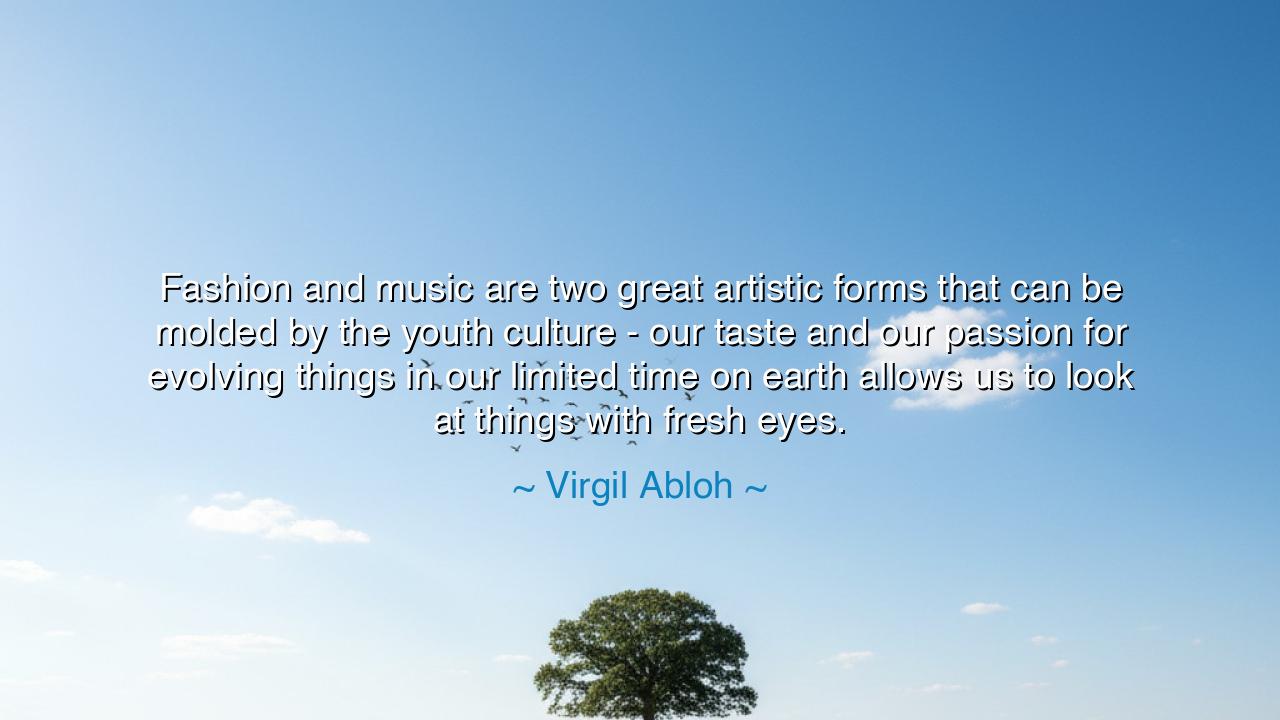
Fashion and music are two great artistic forms that can be molded
Fashion and music are two great artistic forms that can be molded by the youth culture - our taste and our passion for evolving things in our limited time on earth allows us to look at things with fresh eyes.






“Fashion and music are two great artistic forms that can be molded by the youth culture — our taste and our passion for evolving things in our limited time on earth allows us to look at things with fresh eyes.” So spoke Virgil Abloh, the visionary who bridged the sacred distance between streetwear and high art, between sound and style, between tradition and the pulse of the present. His words rise not merely as an ode to creativity, but as a hymn to the spirit of youth, that restless, ever-renewing force which reshapes the world again and again with each generation. To understand him is to understand that art, when guided by young hearts and curious minds, becomes more than beauty — it becomes movement, language, and revolution.
In the ancient world, youth was seen as divine fire — the energy of becoming, unbound by the weariness of the past. What Abloh calls “fresh eyes” is that same sacred sight that sees not what is, but what could be. To the young, nothing is fixed; everything is clay, ready to be molded. They do not ask permission to create; they simply do. Fashion and music, in his eyes, are the perfect vessels for this eternal renewal. They live and breathe through change — woven from the emotions, identities, and dreams of those who dare to express themselves. What marble was to the sculptors of old, the rhythm of sound and the fabric of style are to the youth of today: raw materials of self-definition.
Virgil Abloh himself was born into this rhythm. Trained as an architect, he became a designer of ideas — blending street culture with the elegance of couture, rap beats with Renaissance form. He saw that youth culture was not rebellion for its own sake, but a new language through which the young tell the story of their time. When he said that fashion and music can be “molded by the youth,” he was naming a truth that runs through history. Every era has its youth who break the old forms: The Beatles remade sound; Basquiat remade color; Abloh remade design. In each, we see the same principle — that creation is not born in comfort, but in curiosity, not in imitation, but in reinvention.
The ancients knew this dance between tradition and renewal. In the festivals of Dionysus, the Greeks celebrated not only order but ecstasy — the joyful chaos that gives birth to art. From that chaos came tragedy and comedy, music and myth, all born from youth’s refusal to let the world grow stagnant. Similarly, the Renaissance was not a return to the old, but a rebirth — young minds reimagining the wisdom of antiquity through new lenses. So too did Abloh call upon his generation to take the heritage of fashion and music — those ancient languages of human feeling — and reshape them into the language of now.
In saying that we are moved by “our limited time on earth,” Abloh touches the tender truth that drives all art: mortality. The youth know, perhaps more instinctively than they realize, that time is short — that life burns fast and must be lived vividly. It is this awareness that gives their creations such urgency, such vitality. They do not build monuments to eternity; they build experiences for the living. Each beat, each thread, each color is a declaration: We are here now. Through fashion and music, they carve their moment into history before it fades, transforming fleeting existence into lasting impression.
This union of passion and impermanence is the secret of cultural evolution. The young do not destroy the past; they reinterpret it. They take the garments of their ancestors and wear them anew. They remix old songs, repaint old ideas, and in doing so, remind the world that art is not a relic — it is alive. Thus, Abloh’s message is not rebellion, but renewal. The artist who truly listens to the voice of youth does not merely create — he revives.
So, my child, take this teaching to heart. Do not fear the fleetingness of life; let it ignite your purpose. See with fresh eyes, unclouded by habit or cynicism. Take the tools that surround you — sound, fabric, language, technology — and mold them into something that bears your soul. Whether you dance, design, sing, or build, let your work be a dialogue between what was and what can be. For every generation is given the sacred task to renew the world. And when your time passes, may your creations speak for you — not as echoes of the old, but as testaments of the new, alive with the eternal flame of youth that never truly dies.






AAdministratorAdministrator
Welcome, honored guests. Please leave a comment, we will respond soon